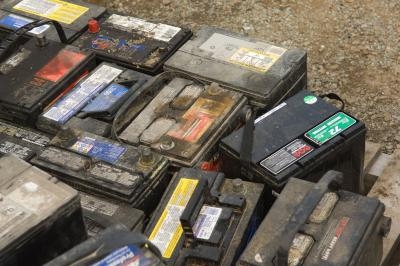
If you try and start your vehicle, and it will not start or only starts on occasion, then you may have a bad battery. A no-start issue is only one of multiple symptoms a bad battery can create. While the battery is primarily only used to start the vehicle, a bad battery can create a multitude of issues with your vehicle's performance. A bad battery can even make it seem like a fuel or spark issue. Testing the voltage on a battery is only one way to determine if the battery is good.
Open the hood of the vehicle, and set the hood prop if equipped. Locate the battery underneath the hood. Remove any obstacles to accessing the battery, using a ratchet and socket. Some vehicles have their batteries are located in the trunk or elsewhere.
Visually inspect the battery. Pay close attention to the sides of the battery to see if they are swollen, or bending outward. Swollen sides on a battery is a sign of a bad battery cells, and will require replacement of the battery. Visually inspect the wires attached to the battery, especially near the battery terminals. Make sure the battery wires are not exposed, and that they are not frayed or disconnected from the lead ends at all. Loose or burned battery wires will need to be replaced with a new battery wiring set.
Open the small caps on the top of the battery with a screwdriver, if your battery is not a sealed unit. Some batteries have water holes built in, which need to be filled from time to time. Check the water level in the battery to make sure these holes are filled nearly to the top with fresh water. Fill the holes with water if necessary. Replace the caps by hand. If your battery has any markings stating "Maintenance Free", or does not have these water caps, disregard this step completely.
Test the connections of the battery wires to the battery, using an open end wrench to make sure the battery leads are properly tightened to the terminals. The leads should be snug to the battery terminals. Do not over-tighten the leads, as this can ruin the battery.
Set an ohmmeter to "V" or the volts setting. Connect the red probe from the ohmmeter to the positive (+) terminal on the battery. Connect the black probe to the negative (-) battery terminal. The reading on a standard 12-volt car battery should be no less than 10.00 volts. If your battery is less than 10.00 volts, charge the battery with a charger. Retest the battery after the charge is complete. If the battery will not fully charge on the charger, then the battery is bad and needs to be replaced.
Start the engine of the vehicle if it will start. Retest the battery voltage with the ohmmeter. A fully charged battery will indicate between 13.50 and 14.50 volts while the car is running. Any readings outside these parameters may indicate your alternator is faulty, rather than the battery.